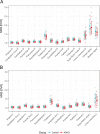Adult attention-deficit/hyperactivity disorder is associated with reduced norepinephrine transporter availability in right attention networks: a (S,S)-O-[11C]methylreboxetine positron emission tomography study
- PMID: 31732713
- PMCID: PMC6858438
- DOI: 10.1038/s41398-019-0619-y
Adult attention-deficit/hyperactivity disorder is associated with reduced norepinephrine transporter availability in right attention networks: a (S,S)-O-[11C]methylreboxetine positron emission tomography study
Abstract
The norepinephrine transporter (NET) has been suggested to play a critical role in attention-deficit/hyperactivity disorder (ADHD). In this prospective controlled study we tested the a-priori-hypothesis that central NET availability is altered in adult ADHD patients compared to healthy controls. Study participants underwent single positron emission tomography-magnetic resonance imaging (PET-MRI). MRI sequences included high resolution T1-MPRAGE data for regions of interest (ROI) delineation and voxel-based morphometry (VBM) and T2-weighted fluid-attenuated inversion-recovery for detection and exclusion of pathological abnormalities. NET availability was assessed by NET-selective (S,S)-O-[11C]methylreboxetine; regional distribution volume ratios (DVR) were calculated based on individual PET-MRI data co-registration and a multi-linear reference tissue model with two constraints (MRTM2; reference region: occipital cortex). VBM analysis revealed no difference in local distribution of gray matter between the 20 ADHD patients (9 females, age 31.8 ± 7.9 years, 488 ± 8 MBq injected activity) and the 20 age-matched and sex-matched control participants (9 females, age 32.3 ± 7.9 years, 472 ± 72 MBq). In mixed-model repeated-measures analysis with NET availability as dependent and ROI as repeated measure we found a significant main effect group in fronto-parietal-thalamic-cerebellar regions (regions on the right: F1,25 = 12.30, p = .002; regions on the left: F1,41 = 6.80, p = .013) indicating a reduced NET availability in ADHD patients. None of the other investigated brain regions yielded significant differences in NET availability between groups after applying a Benjamini-Hochberg correction at a significance level of 0.05. Overall our findings demonstrate the pathophysiological involvement of NET availability in adult ADHD.
Conflict of interest statement
The authors declare that they have no conflict of interest.
Figures




References
Publication types
MeSH terms
Substances
LinkOut - more resources
Full Text Sources
Other Literature Sources
Medical

